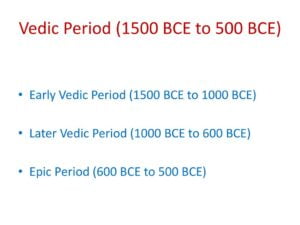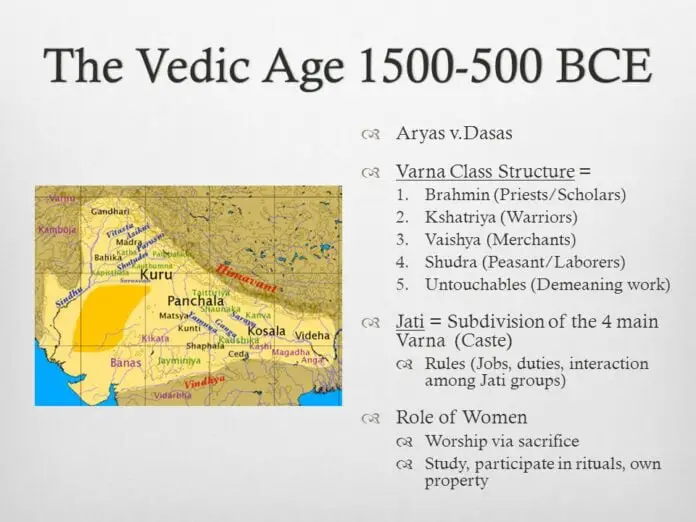Vedic period (1500-600 BC)

The Vedic period is divided into two parts.
1. Literary Evidence – Rigveda
2. Archaeological Evidence
(1) 13-room building
(2) Bogajkoi inscription (1400 BC) obtained from Bhagwanpura in Haryana: – This inscription located in Asia Minal contains the Hiti king Subbilima and Mitani king Matija. There is a mention of the treaty between whom Indra, Mitra, Varuna, and Nastya Vedic deities are considered as witnesses.
(3) Chattered gray pottery
Rigveda
◆ It consists of 10 circles and 1028. 1017 (Sakal Sukta), 11 (Valakhilya Sukta).
◆ Second Circle – Gritsamad Bhargava.
◆ Tihara Mandal – Vishvamitra
◆ Chaitra Mandal – Vamdev
◆ Fifth Circle – Atri
◆ Sixth Circle – Bhardwaj
◆ Seventh Circle – Vashistha
◆ Second to Seventh Circle is called Gotra Mandal.
◆ The eighth circle was composed by Kanva and Angiras.
◆ 9th Circle is dedicated to Somdevata.
10th Circle is described as a famous male Sukta, in which the caste system is first mentioned.
The priest of the Rigveda called ‘Hota’ or ‘Hotra’.
The original Vedic period place of aryo
◆ Ganganath Jha – Brahmarshi Pradesh
◆ Max Müller – Central Asia
◆ Bal Gangadhar Tilak – Arctic (Northern Dhruv) Region
◆ Dayanand Saraswati – Tibet Pradesh
◆ Brendistaine – Kyrgyzstan, situated under the Ural Mountains
◆ The most popular opinion is of Brendertine.
◆ Arya was not really a caste but a group of people speaking the same language.
Their language was Indo-European.
◆ The Aryans did not displace at the same time, but they came in many groups.
◆ Aryo had a war with the people of his own tribes, those who lost were called slaves.
◆ When Aryo defeated Anaryo, he was called Dasyu.
Political expansion of aryo
◆ The important tribe of Aryans was ‘Bharata’, whose ruling class was called ‘Tritsu’.
The famous king of the same dynasty, Sudas, had a famous ‘Dasharajna’ war with 5 Aryas (Puru, Yadu, Turvus, Anu, Duhay) and 5 Anaryos (Akitra, Bhalanas, Pakth, Shivi, Vivian)
The priests of Sudas were distinguished and the priests of the opposing association were Vishwamitra. After this, this country was named India.
Note: – There is a discussion of the only Gandhari region in the Rigveda. This span is the area of Peshawar and Rawalpindi in present-day Pakistan.
Rivers mentioned in the Rigveda
10 There is a description of the river containing the tenth in the 10th division of the Rigveda.
◆ A total of 42 rivers have been discussed and names of 19 rivers have been given.
The area from Sutlej to the Yamuna was called Brahmavat.
Indus (Sushoma) and its 5 tributaries were under the Saptasandhav region.
(1) Vitasta (Jhelum) (2) Askini (Chenab) (3) Purushani (Ravi) (4) Vipasa (Vyasa) (5) Shatudri (Sutlej) and Saraswati river were included.
◆ Sindhu was the most important river and the most sacred river was Saswati. It has been called Naditama (Mother of Rivers).
Mountains
◆ Aryo has described the Sumeru mountain in Rigveda where there are 6 months and 6 months.
◆ Tilak in his book Geeta Rahasya has considered the origin of Aryo from the Dhruva originated on this basis.
◆ The Himalayas have been called the Himwant Mountains, but the most important mountain was Moojwant, from where Mon was obtained.
The word ‘Dhanva’ was used for desert and the word ‘Parjanya’ for the cloud. (Vedic period)
Principle of monarchy
◆ At this time the smallest unit of administration was Kutumb. Whose head was the Vice-Chancellor / Vice-Chancellor?
A village was formed from various clans whose head was Gramani.
◆ Gram has been discussed 13 times in the Rigveda. The Kud villages used to make ‘Vish’, whose head was the Vishpati (Discussion – 170)
◆ Some Vish used to make ‘Jan’ together, who was the king. In the Rigveda, it has been called Gopa Janaya. (Discussion-275).
The Republic has been discussed 46 times in the Rigveda but in the Earth Veda, it has been discussed only 9 times. That is, by the time of the later Vedic period, the democratic system had become weak.
In Rigveda, two organizations named Sabha and Samiti existed, elite and old men used to participate in the assembly (8) and common people participated in the committee (9).
These two originated from an organization called Vidith, which has been discussed 122 times.
◆ Only women were entitled to participate in the assembly.
विक Ludwick has compared the House to the Tula Rajya Sabha and the Committee to the Lok Sabha.
The main tax levied at this time was ‘Bali’.
The slaves gave it voluntarily and it was compulsorily taken from the bandit.
The names of some other Vedic officials are also found in the Rigveda.
Vajrapati – Officer of the pasture. Touch detective.
The social life of aryo
The main occupation of the Aryans was animal husbandry, hence they have been called ‘Tradhishi’ which means transmission modesty.
◆ When Arya started taking permanent residence at one place, then he came to be called ‘Krushti’ i.e. the cultivator.
◆ Aryo’s favorite animal was a horse at this time, because of its rapid pace, Arya was successful in conquering this region.
The cow of the most religious importance of the Aryans was the cow. The rich person is called Gomat or Dravida.
The term ‘twilight’ has been used to measure time.
Distance measurement has been used as ‘Gavayatu’ and ‘Gavishi, Gesu, Gatya, Gomya’ for war.
◆ Raja has also been called ‘Gopa Jansya’.
◆ The daughter is called ‘Duhita’.
◆ At this time the fall for the plow was made of wood and the plow has been called ‘longal’ and ‘seer’.
◆ Aryans were both vegetarian and non-vegetarian.
◆ Kheer has been called ‘Ksheer Pakodanam’.
A food called Karambha was prepared by mixing Satu of barley with curd.
◆ Arya used to eat horse meat during Ashwamedha Yagya.
◆ Guests were served cow meat, so guests have been called ‘Gohan’.
◆ Arya mainly wore cotton and woolen clothes.
The Gandhari region was famous for wool.
The ‘Vasas’ of the clothes worn below the waist and the clothes worn above the Vasas were called ‘Abhivasan’.
The word ‘vaapta’ has been used for the barber.
Salt is not mentioned in Rigveda.
The condition of women
During the Rigvedic period, the condition of women was good, marriage was considered a sacred bond. The daughter is called Duhita.
In the Shatapatha Brahmin, women are called Adradhagini.
In the Rigveda, ‘Zaidesam’ means women.
◆ Women were allowed to choose their husbands, the gift given at the time of marriage was grand.
◆ At this time there were female women like Lopa Mudra, Ghosha, Vishwavara.
Women who remained unmarried throughout their lives were called ‘Amaju’ and had rights in their father’s property.
◆ At this time the desire for a son was more and the practice of niyoga was also prevalent in the society. (Scholarly woman-sage, Brahmavadini)
The clothes worn on the occasion of marriage were called Vaghayu.
◆ With the right to participate in Vidith and Sabha, but not in the committee.
Residents of this time had knowledge of gold, silver, copper, bronze.
◆ Aryo did not have knowledge of iron.
Carpenter was called Tashan and it was the main of craftsmen.
◆ Weaver was called ‘Tantuya’ and the potter was called ‘Kulal’.
◆ Trade and regulation were through a metal called ‘Nishk’. It used to be a body made of gold.
◆ The credit system was also prevalent and interest was called ‘Kusidin’.
Rigvedic religion
Rigvedic religion was based on ‘utilitarianism’.
It was a practical trend and considered to be the Mars form of the world.
◆ It was the deity of nature and in this deification, the male deity was predominant.
◆ The most ancient deity (of the Aryans) houses $ earth, earth, earth. (Vedic period)
1. Indra –
250 Indra is dedicated 250 sukta in the Rigveda.
(1) Tonan – In this form, he led the Aryan tribes and called ‘Purandar’ because of breaking the fort.
(2) Atsujit – In this form, he killed the Vritra Rakshasa and freed the water and hence called ‘Purabhid’ or ‘Puluvi’.
◆ Indra is considered the god of war and rain.
◆ Its famous Ordnance was Vajra which was made from the bones of sage Dadhichi.
2. Agni –
◆ He was the second most important deity.
200 200 Suktas have been dedicated to them.
◆ He has been called the God of Yagya and Griha.
◆ Earlier they used to live in gold, the Goddess Matarishvin took them to Earth, and Arya and Mrigu and Angirash Rishi distinguished them in Yagya Vedi For this reason, both these sages are called ‘Arthavan’.
◆ They act as intermediaries between gods and humans.
Because they are lit in every house, they are called ‘Atithi’.
3. Varun –
◆ He is the god of water. He has 30 suktas dedicated to him.
◆ He is devoted to the most emotional and sublime sukta.
It is necessary for a person to be pure for their sexual appearance.
◆ They follow Rit (moral help), hence they are called Ritasya Gopas.
◆ He was an Aryan deity similar to ‘Ahuramazda’, the god of Iran.
4. Mon
114 Sukta Som in the 9th Circle is dedicated to the deity.
This samara is called Andhasu, Pitu, Piyush, Amrit.
◆ Som is considered the god of forest and vegetation and medicine. (He has been compared to the Greek deity of Greece)
In Praviktikaal, Soma is compared to Chandramus.
5. Mitra (Varuna’s associate)
◆ He is considered the god of oaths and vows.
6. Ashwini (Nastya)
◆ He was the god of medicine.
In the Rigveda religion, only Rudra has been called the deity related to civil conduct.
7. Pushan: God of Shudras.
8. Aryaman – God of Marriage
9. Ribhu – God of Metal
Women of the Rigvedic religion are also mentioned.
◆ such as – Aditi, Usha, Nisha, Aranyayi.
◆ The famous Gayatri Mantra is dedicated to Surya and it describes the praise of Savita (rays of the Sun).
जिन Two Jain Tirthankaras are mentioned in the Rigveda as ‘Jin and Aryashtinemi’.
Rigveda philosophy
Rigveda’s philosophy was oriented towards monotheism and monism. It was based on utilitarianism.
Moksha is not mentioned in this religion and more emphasis is placed on prayer rather than Yagya.
◆ However, in the Rigveda, there is mention of Krishtapurtha (gold) and Avratas (hell). (Vedic period)
www.GKDuniya.in will update many more new jobs and study materials and exam updates, keep Visiting and share our post of Gkduniya.in, So more people will get this. This content and notes are not related to www.GKDuniya.in and if you have any objection over this post, content, links, and notes, you can mail us at gkduniyacomplaintbox@gmail.com
And you can follow and subscribe to other social platforms. All social site links in the subscribe tab and bottom of the page.
Important Links
Particulars Official Links Related Links
Official Site View more at website
You-tube GKDuniya9
Instagram GKDuniya.in, IndiaDigitalHub
Facebook GKDuniya.in
Another site visit Indiadigitalhub.com
Get new updates Click here



